I’m made of glass, this much is true. but when you look, you won’t see through. reflect on this, and you’ll find a clue!
Mirrors, i know most of us have like this in our homes. And for sure no day that we failed to stay in front and see our “reflection”. Reflection? It sounds familiar right? In terms of physics, what does really reflection mean? Lets find out.
What I Knew?
Honestly i do not know really that much about the reflection but of course when i hear the word reflection the first thing that always came to my mind is the mirror. Maybe we already tackled this one during on my lower grade levels but I can’t really remember.
What I Learned?
The capacity to learn is a gift; the ability to learn is a skill; the willingness to earn is a choice.
-Brian Herbert
In this lesson i learned a lot. Of course i know some things on reflection but in here i learned about the concepts and law of reflection. New knowledge sometimes is not that easy to understand but with the help of our teacher and my group mates it somehow made things easier.
So let’s start discussing the things I learned in our class. First is on the Law of Reflection.
Law of Reflection
The law of reflection states that when a light ray is incident on a plane surface, then the incident ray, the reflected ray and the normal to the surface of the mirror all lie in the same plane.

In here it shows the light ray approaching the mirror is known as the incident ray, while the one that bounces off the mirror is called the reflected ray.
The straight line where the incident ray meets the mirror is called the “normal”.
ANGLE OF INCIDENCE
The angle between the incident ray and the normal
ANGLE OF REFLECTION
The angle between the reflected ray and the normal
POINT OF INCIDENCE
The point at which light falls.

LAW OF REFLECTION
The Angle of incidence is equal to the angle of reflection
i=r

>The law works for FLAT, PLANE surfaces only.
>The angles are measured from a perpendicular line to the surface called a NORMAL.
The incident ray, refracted ray and the normal to the reflecting surface at the point of incidence lie on the same plane.
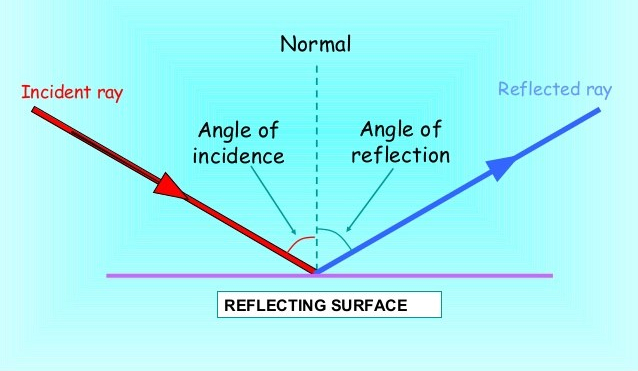
MULTIPLE REFLECTION
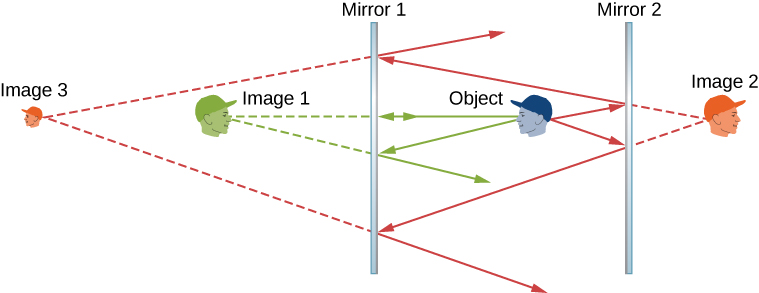
A mirror reflects everything in front of it including another mirror. If you place two mirrors at an angle, you increase the number of reflected images you can see. Depending on the angle you choose, you can see a number of unbroken reflections and one or more composite or partial reflections.
Increasing the number of flat mirrored surfaces or facets increases the number of reflections, but what you see depends on where you stand. The number of complete and partial reflections changes as you view the mirror from different angles.


Real image appears in front of the mirror (could be projected onto a screen)

Virtual – image appears behind the mirror

Enlarged – image is larger than the object
Reduced – image is smaller than the object
Same – image is the same size as the object

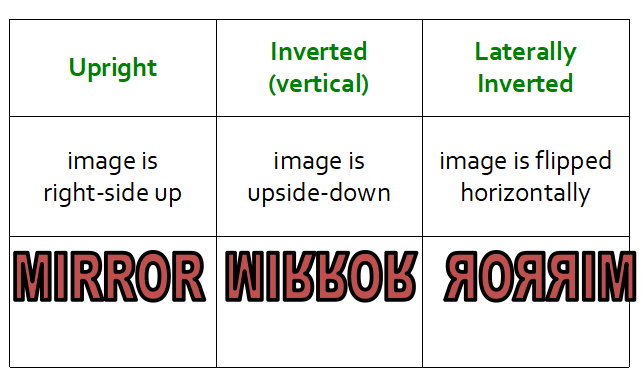
Image formation on plane mirrors
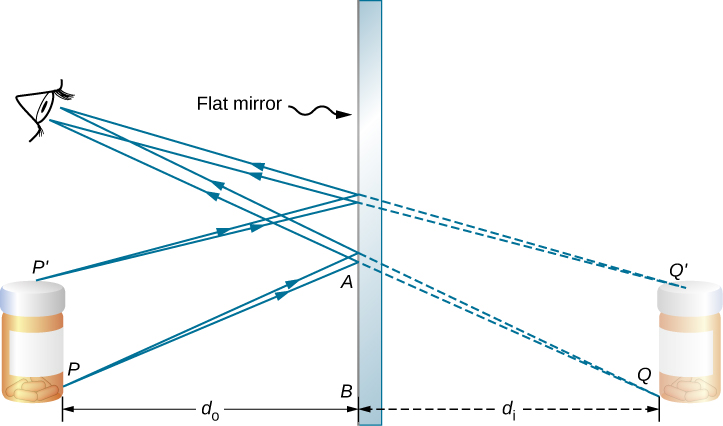
As you see from the picture we send rays from the top and bottom of the object to the mirror and reflect them with the same angle it hits the mirror. The extensions of the reflected rays give us the image of our object.
The orientation and height of the image is same as the object. In plane mirrors always “virtual image” is formed.
Virtual image is an image formed by light that does not come from the image location (but it appears to come from the image)

The distance between the image and the mirror is equal to the distance between the object and the mirror
Image formation on curved Mirrors

Concave Mirrors

Since the mirror is spherical it technically has a CENTER OF CURVATURE, C. The focal point happens to be HALF this distance.

The characteristics of an image formed by a concave mirror depend
on the location of the object. As it turns out, there are six “strategic”
locations where an object may be placed. For each location, the
image will be formed at a different place and with different
characteristics.
Also called CONVERGING mirror

The focal length (f) is from the focal point (F) to the vertex point (V)

Ray Diagram
A ray diagram is a pictorial representation of how the light travels to form an image and can tell you the characteristics of the image.
A ray parallel to the principal axis is reflected through the focal point (F).
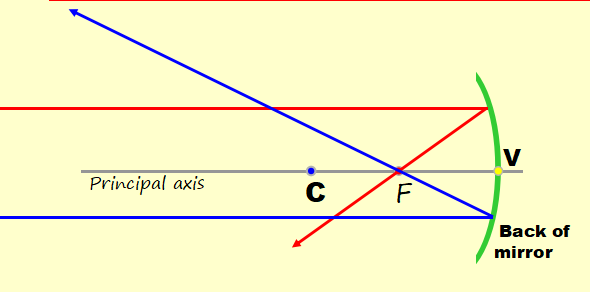
A ray that goes through the focal point (F) is reflected parallel to the principal axis.


Due to the great distance the object is from the mirror,
all rays arrive at the mirror parallel to the principal axis.
As a result, all rays focus at the focal point and no image
is formed.

Image is real, between C and F, inverted and reduced.
Object just beyond C

Image is real, located at C, inverted and same height as object.
Object at C

Image is real, located beyond C, inverted and larger than the object.
Object between C and F

All rays are reflected parallel and thus no image is formed.
Object at F

Image is virtual, located inside the mirror, upright and larger than the object.
Object between F and V (within the focal length)
Convex Mirrors
For convex mirrors, the image is always virtual, always located inside the mirror, always upright and always smaller than the object.
Also called DIVERGING mirror

The Mirror Equation

The mirror equation expresses the quantitative relationship between the object distance (do), the image distance (di), and the focal length (f).

The Magnification equation relates the ratio of the image distance and object distance to the ratio of the image height (hi) and object height (ho).
Here is how this works:
If we get a POSITIVE magnification, the image is UPRIGHT.
If we get a NEGATIVE magnification, the image is INVERTED
If the magnification value is GREATER than 1, the image is ENLARGED.
If the magnification value is LESS than 1, the image is REDUCED.
If the magnification value is EQUAL to 1, the image is the SAME SIZE as the object.
Practical uses of the different types of mirrors
There are different types of mirrors made from different materials. When it comes to using mirrors, it is important to know the various types so you can make the most out of any mirror that you might have.
Plane Mirror

It has a flat or planar reflecting light rays in the order they are received. The virtual image that plane mirrors produce is the same size and distance as of the real objects. Though the image seen in a plane mirror will appear to be backward because it is reversed left to right.
In most of the measuring instruments, a plane mirror placed under the scale and pointer moves, the image in the plane mirror also moves.
Spherical Mirror
These can be concave or convex mirrors. A concave mirror has its glass plate curving inward similar to the way a teaspoon is curved and then coated with mercury. Concave mirror is bulge outward, similar to the back of a teaspoon.

Uses of Concave mirrors
- It used in shaving to get an enlarged and erect image of the face.
- Concave mirrors used in marine lighthouses that are found at the marine ports and seaports to guide the ships.
- It is used in the solar furnaces to collect a large amount of solar energy in the focus of the mirror for cooking, heating water, recharging power backups or melting metals respectively.
- It is used in front lights of cars to reflect the light.
- Concave mirrors are using in telescopes; dentists use them to obtain a large image than the original teeth, ear or skin.
- They also used in electron microscopes and magnifying glasses.
- Flashlight of the camera uses this types of mirror.
Uses of Convex Mirrors
- It is used as a side view mirror on the passenger’s side of a car because it forms an erect and smaller image for the way behind the car.
- It is suitable for a convenient shop and big supermarkets and any other corner where need anti-thief.
- It is used turning off the road and parking.
- Vastly used in making lenses of sunglasses.
- They can be used as street light reflectors because they can spread light over a big area.
One-Way/ Two-Way Mirrors

One way mirrors also known as two-way mirrors. They often associated with observation rooms and security applications where viewers on one side of the glass may look through the window without being seen on the other side.
These types of glass mirror effects are commonly seen on the television and in the movies.
Uses Of One Way/ Two Way Mirrors
- Two way mirror used for security surveillance for example department stores or banks.
- They used for monitoring work areas in offices, warehouses, and large stores.
- It is used to protect hidden cameras.
- It used in observation rooms where the distraction of onlookers maybe unwanted. For example daycare, dance schools, science labs.
How I learned?
As I said a while ago learning new things is not that easy. And learning and doing some activity is a great tool to help me understand more what the lessons talked about. I can say that doing activities with my group mates helps me a lot though in this activity we somehow argued but in a good way.
OBJECTIVES
- To determine the relationship between the angle of incidence and the angle of reflection
- To determine the relationship between the number of image reflection and the angle of separation
Angle of Reflection

Choose an angle using the protractor then put the push pins on it

- Put another pushpin diagonal with the image created in the mirror.
Each member of the group choose the angle they want except for 90 and 180 degrees.
Angle of Separation

- Place the pair of mirror on the origin of the Cartesian Plane based on its certain angles.
- Put an object at the center.
- Count the number of objects shown in the mirror
Findings from the Activity conducted
Angle of Separation

Angle of Reflection

Concave Mirror
| OBJECT | L | O | S | T |
| 15 cm | 7 cm | Inverted | Reduced; hi= -1.5 cm | Real |
| 10 cm | 8.8 cm | Inverted | Reduced; hi= -2.5 cm | Real |
| 7 cm | 11.2 cm | Inverted | Enlarged; hi= -4.5 cm | Real |
| 5 cm | No image | No image | No image | No image |
| 3cm | 5.5 cm | Upright | Enlarged; hi= 7.5 cm | Virtual |
The Magnification equation relates the ratio of the image distance and object distance to the ratio of the image height (hi) and object height (ho) was use in this activity.
Reflection
Reflection… just like the mirror it reflects the things we put in front of it. Just like us, sometimes we need to reflect on ourselves, on the things we’ve done. We need to see things in not only one angle but it must be in different angles.
There are times where we see only one image, which we think its the only right thing that we almost forgot that we still have different angles to see new image, to see new things.
In this lesson, it does not only teach us about laws but it is also reminder to reflect on ourselves. Let’s not only focus into one angle, into one side. There are still other sides where things might be better.

You must be logged in to post a comment.